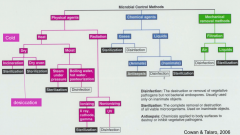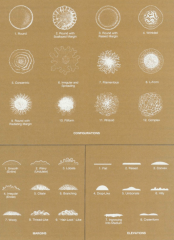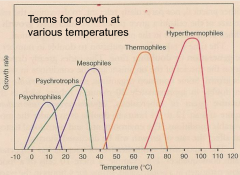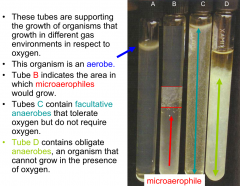![]()
![]()
![]()
Use LEFT and RIGHT arrow keys to navigate between flashcards;
Use UP and DOWN arrow keys to flip the card;
H to show hint;
A reads text to speech;
55 Cards in this Set
- Front
- Back
|
acid fast stain
|
Acid fast stains are a type of differential stain used to detect acid fast bacilli. The most famous acid fast bacilli is Mycobacterium tuberculosis.
|
|
|
aerobe
|
An aerobic organism or aerobe is an organism that can survive and grow in an oxygenated environment.
Obligate aerobes require oxygen in order to survive and multiply. |
|
|
agar
|
Media is made solid using a substance know as agar. Agar, made from marine algae, gives solid media the consistency of gelatin.
|
|
|
anaerobe
|
An anaerobic organism or anaerobe is any organism that does not require oxygen for growth. It may react negatively or even die if oxygen is present, which means that it can perform its bodily functions better in the absence of oxygen.
Obligate anaerobes, which are harmed by the presence of oxygen Aerotolerant organisms, which cannot use oxygen for growth, but tolerate the presence of it Facultative anaerobes, which can grow without oxygen but use oxygen if it is present |
|
|
biochemical reaction
|
.
|
|
|
broth
|
Liquid media is known as broth. Microbial growth in broth is based on cloudiness, or tubidity.
|
|
|
colony
|
A colony is a visually discrete amount of growth that is considered to have been formed for a single bacterium, or colony forming unit. All the bacteria in a colony are clones of the CFU.
Colonial characteristics include color, configuration, margin, and elevation. |
|
|
culture
|
Culture is the processing of growing microorganisms in the laboratory by proving microbes with an environment that allows the organism to grow.
|
|
|
disinfectant
|
Disinfection and disinfectants inhibit growth of microorganisms on inanimate objects.
|
|
|
fastidious
|
Fastidious organisms require specialized media to grow.
|
|
|
fermentation
|
Fermentation is a metabolic process that converts sugar to acids, gases and/or alcohol. It occurs in yeast and bacteria, but also in oxygen-starved muscle cells. Fermentation takes place in the absence of oxygen, when the electron transport chain is unusable. It is used by the cell not to generate energy directly, but to recycle NADH into NAD+ so that glycolysis can continue, as long as glucose is present.
|
|
|
fluor
|
A fluorescent stain is a type of differential stain. It uses fluors that are activated by ultraviolet light and glow or fluoresce when activated.
|
|
|
gradient
|
.
|
|
|
Gram stain
|
Gram stains are a common differential stain used in the microbiology laboratory. It is used to differential between Gram positive and Gram negative bacterial based on the cell wall composition.
|
|
|
hemolysis
|
Hemolysis is the rupturing of erythrocytes (red blood cells) and the release of their contents (cytoplasm) into surrounding fluid (blood plasma).
|
|
|
immunodiagnostic test
|
Immunodiagnostic tests are one method used to identify bacteria and fungi. They utilize the specific binding of antigens and antibodies to help microbiologists identify pathogens.
|
|
|
incineration
|
Incineration is the process of burning to ashes. It is a physical method used to control the growth of microbes.
|
|
|
media
|
Medium is any substance that provides a source of carbon and energy for an organism. Media can be either solid or liquid (broth).
There are different types of media including supportive, enriched, differential, selective, and specialty media. |
|
|
microscopy
|
Microscopy is the technical field of using microscopes to view samples and objects that cannot be seen with the unaided eye (objects that are not within the resolution range of the normal eye). There are three well-known branches of microscopy: optical, electron, and scanning probe microscopy.
|
|
|
molecular test
|
Molecular testing is based on the unique sequences of DNA found in every organism.
|
|
|
Petri plates
|
Petri plates are shallow plastic or glass containers with clear tops in which medium is usually placed. They are constructed to have a loose lid to allow for the flow of air over the media and are stored and incubated upside down with the lid on the bottom. Labels are always put on the bottom of the plate.
Filled uninoculated Petri plates are stored at 4C. |
|
|
spectrum
|
.
|
|
|
sanitization
|
Sanitization is the process of cleaning an area to remove microorganisms
|
|
|
turbidity
|
Turbidity is not clear or transparent because of stirred-up sediment or the like; clouded; opaque; obscured
|
|
|
Cidex
|
Cidex is one trade name for gluteraldehyde (o-phthalaldehyde. It is an aldehyde that is a chemical method of microbial control.
|
|
|
halogen
|
Halogens are a chemical method of microbial control. It includes chlorine and iodine. They interfere with disulfide bonds found in proteins, especially enzymes.
Chlorine gas is used to purify water Hypochlorite is found in bleach. Iodophors (iodine-containing) - Betadine, Povidone, Isodine Chlorinated water was the first disinfectant used by Ignaz Semmelweis. |
|
|
hyrdogen
|
.
|
|
|
oxidizing agents
|
Oxidizing agents are a chemical method of microbial control. Oxidizing agents create free radicals which are hyperactive chemicals that must bind to another chemical. Their primary action is the disruption of cell membranes.
Ozone can be used in the place of chlorination for water treatment. It will kill Cryptosporidium which is resistant to chlorine. Ozone is a chemical method of microbial control. Hydrogen peroxide (H2O2) is also an oxidizing agent. |
|
|
lyophilization
|
Lyophilization is freeze-dried, a process in which a liquid is frozen and then the frozen water is removed by a vacuum.
Desiccation is the process of using heat to remove water. These processes are physical methods for controlling the growth of microbes and neither result in sterilization. |
|
|
ozone
|
Ozone can be used in the place of chlorination for water treatment. It will kill Cryptosporidium which is resistant to chlorine. Ozone is a chemical method of microbial control.
|
|
|
Zephiran
|
Zephiran is a trade name for a quaternary ammonium detergents (quats). Quats are more effective than soaps and detergents and damage the cell membrane. They can be either bacteriostatic or bacteriocidal.
Quats are not effective against Mycobacterium tuberculosis, Pseudomonas aeruginosa, hepatitis virus, or spores. Quats are widely used in the restaurant settings. Soaps and detergents, including quats, are a chemical method for microbial control. |
|
|
autoclave
|
Autoclave is heat under pressure. Autoclave temperature reaches 125C and must be maintained for 15 minutes at 15 psi for effectiveness. Autoclave is sporocidal.
Indicators can be used during the autoclave process. Heat sensitive tape can be used to label autoclaved materials. Other tests that test for endospores after autoclaving can indicate an ineffective cycle. |
|
|
creation of a lawn of bacteria
|
Lawn of bacteria is an inoculation technique used with solid medium (agar). The goal is to have colonies touch each other or confluent growth. It is used to test various antimicrobial agents using paper disk tests.
|
|
|
filtration
|
Filtration is a mechanical method of controlling microbial growth. It can be used with liquids and gases. Microbes are removed using a filter to catch and trap them.
|
|
|
identification
|
Bacteria and fungi can be identified using microscopy, culture and biochemical reactions, immunodiagnostic tests, and molecular tests.
|
|
|
incubation
|
Microrganisms are incubated to allow them time to grow. Visible growth for most bacteria requires at least 18-24 hours incubation at 37C.
Depending on the size of the incubato, a fan may be built in. Plates left in the incubator for extended periods will dry out. |
|
|
inoculation
|
Inoculation is the act of placing the organism on growth medium. Care must be taken to ensure aseptic transfer of the organism.
Different methods of inoculation can be use depending on the goal of the culture. The quadrant streak is used to isolate colonies by distributing fewer and fewer bacteria on the plate. The lawn of bacteria is used to have colonies touch each other. |
|
|
inspection
|
Inspection requires a visual assessment of the colonies to determine how many different types of organisms are present.
One type of observation of microbial growth in broth is based on cloudiness, or turbidity. Measurements of turbidity are useful in various microbiology tests. |
|
|
irradiation
|
Irradiation is a safe and effective process to decrease or eliminate harmful bacteria and extends the shelf-life of food. It is a physical method of controlling microbial growth.
|
|
|
isolation
|
.
|
|
|
pasteurization
|
Pasteurization uses 140C for 3 seconds followed by rapid cooling in a vaccum. It was developed by Louis Pasteur.
|
|
|
pH
|
pH is a chemical method for controlling microbial growth.
|
|
|
quadrant streak technique
|
The goal for quadrant streak is to produce isolated colonies by distributing fewer and fewer bacteria on the plate.
|
|
|
differential media
|
Differential media allows the differentiation of specific organisms or groups of organisms.
MacConkeys agar differentiates between GNR that either ferment lactose or do not ferment lactose. Color change is due to the pH indicator neutral red. Mannital Salt agar differentiates between Staphylococcus aureus and other Staphylococcus species based on the fermentation of mannitol. Phenol red turns yellow at an acidic pH. |
|
|
enriched media
|
Enriched medium provides additional nutrition when compared with supportive medium.
Blood agar (plate) (BAP) adds 5 - 10% sheep blood. BAP can also be used to determine hemolytic reactions. |
|
|
selective media
|
Selective media select for certain bacteria and inhibit the growth of others.
MacConkey agar selects for gram negative rods and inhibits Gram positive cocci organisms because gram positive cocci are inhibited by the bile salts in the agar. Mannital Salt agar is selective because of a high concentration of salt. Most medium have 0.5% NaCl but Mannital Salt agar has 7.5% NaCl which inhibts the growth of many organisms bu allows staphylococci to grow. |
|
|
specialty media
|
Specialty media provide additional nutrients not found in enriched media that are required by fastidious organisms.
Lowestein-Jensen provides nutrients not found in BAP and is used for the isolation of Mycobacterium tuberculosis. |
|
|
supportive media
|
Supportive media supports the growth of many different organisms but does not provide for more than basic nutritional needs.
Tryptic soy agar and nutrient agar are examples of supportive media and are not commonly used in clinical laboratories. |
|
|
essential nutrients
|
Essential nutritional elements - (CHONPS)
carbon hydrogen oxygen nitrogen phosphorus sulfur |
|
|
Microbial Control Methods
|

.
|
|
|
Spectrum of light waves
|

|
|
|
Colony characteristics
|

|
|
|
Isolated colonies
|

|
|
|
Terms for growth at various temperatures
|

|
|
|
image
|

|

